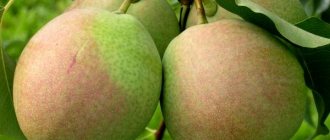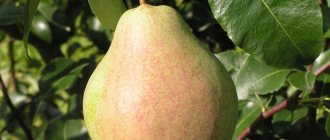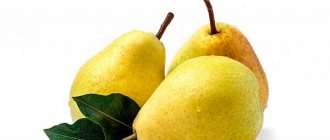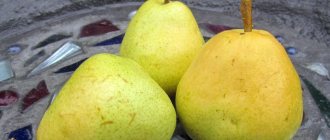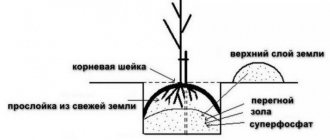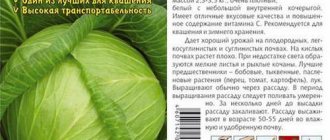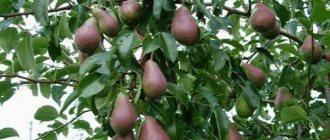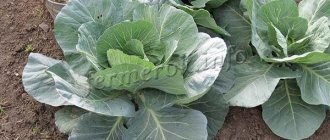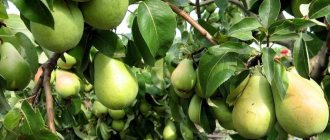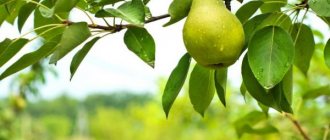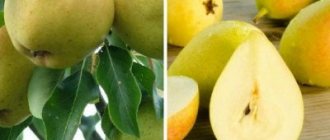History of the variety's creation
Late Belorussian pear is a representative of winter varieties that are distinguished by an abundant yield of tasty fruits and tolerate severe frosts. Therefore, this tree is in great demand in the Central Economic Region, where a temperate continental climate prevails.
As the name suggests, the birthplace of the variety is the Republic of Belarus. It was bred in the 60s of the last century at the Belarusian Research Institute of Fruit Growing, located in the Minsk region. Its authors are talented breeders N.I. Mikhnevich, N.G. Myalik and Yu.K. Kovalenko, who used the French pear Good Louise in their work.
In Belarus, pear received official permission for cultivation in 1989. In the Russian federal institution “Gossortkomission” it appeared in the register only in 2002. The Central and Northwestern regions were identified for its cultivation, where it showed good productivity.
Belorussian late is often chosen as one of the main types of pear trees when forming industrial orchards in Belarus, Russia and the Baltic states. The variety is also used in breeding trials and becomes the basis for creating new varieties of fruit trees.
History of selection of the Belorusskaya Late pear
The breeding of a new variety of winter pears began in Belarus in the late 90s. 20th century in order to obtain an improved type of fruit with high yields, suitable for cultivation in the climate of the middle zone and northern regions.
The selection of Belorusskaya Late began through free pollination of the French pear variety under the authorship of scientists Mikhnevich, Kovalenko and Myaglik. The procedure significantly improved the characteristics of the crop, and also helped to adapt to the local climate. Since 2002, the pear has been included in the State Register and is actively grown in Russia.
Description of the variety
Belorussian late is a winter ripening pear. Bred at the Belarusian Research Institute of Fruit Growing. It has been approved for breeding in the Russian Federation by the State Register since 2002. The variety has sufficient winter hardiness and very high yield - about 160 c/ha. Fruits regularly.
From one young Belorussian late tree you can harvest 70–100 kg of pears, from an adult tree - up to 180 kg.
Trees of this variety grow to medium size and have a rounded crown that is prone to strong thickening. The branches are geniculate, not too thick. The buds are small, the leaves are also small, light green with a smooth surface and short petioles. The flowers are large, white, with oval-shaped petals. Ovaries are formed on all fruit formations.
The branches of the Belorussian late are literally strewn with fruits
Pears of this variety begin to bear fruit in the third or fourth year of life. The pears are medium-sized, weighing on average 110 g, regular in shape, with dull, dry skin. The surface is rough, with pale brown dots.
Small, strong fruits will be stored until spring
The fruits are harvested when they are mostly green in color, with a reddish-brown tint on the sunny side. Fully ripe pears acquire a rich yellow color with a bright crimson blush. The pulp is white, very juicy, semi-melting, with fine grain. The taste is sweet, with slight sourness, and has a medium-strong aroma.
Tree
Late Belorussian pear is a medium-sized plant. The crown is very dense, usually in the shape of a ball. The main branches extend from the trunk at an angle of 90 degrees. The ends of the branches are directed upwards. The first fruiting is observed at 3-4 years. The average height of an adult tree is 3-5 m. The crown volume is from 2.5 to 4 m.
The shoots are of medium thickness with a round cross-section and a fleecy surface of light brown color. The cone-shaped buds are small and pubescent. Lentils are numerous. The leaves are medium sized and oval shaped. The edges of the leaf blade are wavy, finely serrated, jagged. The leaf surface is smooth, the structure is dense, the color is light green. The flowers are large. Petals are elliptical (mostly white).
Trees of the Belorusskaya late variety have a rounded dense crown
Fruit
The fruit size is average - about 90-110 g. The shape is elongated. The skin is dull and rough. The surface of the fruit is covered with light brown ripples. Color varies depending on the degree of maturity. During the harvesting period, pears are green with brownish-red spots; during the period of consumer ripeness, they are yellow with a slight orange tint and a crimson blush.
The pulp of the fruit is white, tender, juicy and sweet in taste. The structure is oily, fine-grained, medium aromatic.
Tasting assessment of the taste of the fruit is 4.2-4.4 points.
The average weight of fruits of the Belorusskaya late variety is 100 g
Tasting assessment and scope of application of pears
The taste qualities of Belarusian Late pears are highly rated. Expert tasting scores range from 4.2-4.4 points out of 5 possible.
Late Belarusian pears are used raw and are also suitable for processing. Compotes, jams, baby food, jams and juices are prepared from fruits. This variety is also used for making dried fruits.
In which regions does it grow best?
The best indicators of yield and quality of Belorussian late fruits are observed in the North-Western and Central regions of the Russian Federation.
Best pollinators
Belorusskaya Late is a partially self-fertile variety. To improve fruiting, additional artificial pollination with combined pollen or planting next to varieties such as Konferents, Bere Loshitskaya, Maslyantaya Loshitskaya is recommended.
Best pollinators
Belorusskaya Late is a partially self-fertile variety. To improve fruiting, additional artificial pollination with combined pollen or planting next to varieties such as Konferents, Bere Loshitskaya, Maslyantaya Loshitskaya is recommended.
Pollinators for the Belorusskaya late pear variety (photo gallery)
The Oily Loshitskaya variety is distinguished by good taste of fruits and high yield.
The Conference variety is well compatible with quince
Bere Loshitskaya is a medium-winter-hardy variety, relatively resistant to bacterial canker and scab.
Characteristics of the winter variety
All information about the tree is important to gardeners. After all, the harvest will not be obtained immediately after planting the seedling. Therefore, you need to determine in advance all the advantages and disadvantages of the variety so as not to make a mistake in your choice. Useful video:
According to the description of the variety, the Belorusskaya Late pear has a high early fruiting rate, so the first harvest can be obtained 3-4 years after planting the seedling. First of all, summer residents are interested in the parameters of the tree, so that even in a small area they can create comfortable conditions for it.
The Belorusskaya Late pear variety is classified as medium-sized. The optimal distance that is maintained when planting this type of tree is:
- from a fence or building to a pear – 3.5 meters;
- between rows of pears (if a garden is planted) - 5 meters;
- between neighboring trees - 4.5 meters.
Reducing the distance is not recommended. If you plant trees closer, each pear will be crowded. For this reason, the branches will interfere with each other, the plant will not have enough sunlight and the yield will noticeably decrease.
The next important characteristic is the time of harvest. The agricultural technology for growing the pear variety and its care requirements depend on the ripening period. The ripeness of the fruits of the Belarusian late winter pear occurs in the second half of September. At the same time, the variety is characterized by high keeping quality. The taste and commercial qualities of pears are preserved for 5-6 months, so you can count on a delicious dessert until the beginning of March.
Advantages and disadvantages
The winter variety of Belarusian pear has long been known to domestic gardeners. It does not lose its relevance today thanks to many positive qualities:
- high productivity;
- fruits of excellent taste;
- long shelf life;
- frost resistance.
Among the disadvantages are:
- average immunity;
- the need to use pollinators to increase harvest volumes;
- thickening of the crown, as a result of which the fruit may not receive enough sun and heat, which has a bad effect on their taste and size.
Landing
The most favorable time for planting Belarusian pears is late spring. You can plant a tree in 3-5 days and within two weeks after the snow has completely thawed.
In addition, planting in the fall is possible. In autumn, trees are planted after leaf fall and before the first frost.
Place and time of landing
Not only its appearance, but also the quality of the fruit depends on where the tree is located. The culture prefers a warm and bright place. It is advisable to place the tree on the south side of buildings or near a fence to reduce the negative impact of cold winds. The lowland is not suitable for this variety, since cool air accumulates in it, and melt water remains for a long time.
The Belorusskaya late pear variety is planted in the spring - before buds appear, after the snow melts. You can plant a pear tree in the fall - before the onset of frost. This will allow the pear to take root before severe frosts, and the sprout will begin to grow next season.
Selection of seedlings
A correctly selected seedling is the key to a good harvest. A grafted plant differs from a wild plant in the absence of thorns on the trunk. The seedling should have elastic branches, dense bark and fresh foliage, the root system should be free of dried and damaged roots.
Landing place
When choosing a place for planting, you should take into account that the pear is a light-loving plant. In addition, for normal development of the tree, a plot of 4x4 meters is required.
An area with fertile black soil is best suited for planting pears. The soil should be loose and moderately moist. Areas where water systematically stagnates should be avoided. On clay and sandy soils, the pear tree develops slowly and bears fruit poorly.
Dimensions and depth of the landing pit
Late Belorusskaya pear seedlings require planting at an average depth of about 0.7 m. The dimensions of the planting hole largely depend on the size of the tree’s root system; usually the diameter should be chosen within 1 m.
Planting technology
The correct time for planting the Belorusskaya Pozdnyaya variety significantly affects the growth of the pear. The tree will take root best if planted in the spring, even before buds begin to appear, immediately after the snow cover has melted. You can plant pears in the fall, but this must be done before the first frost has passed. In this case, the growth of the seedling will begin with the onset of spring.
The technology for planting the Belarusian Late Pear involves:
- A recess is made in the planting hole.
- The soil mixture forms a small mound at the bottom.
- The roots are evenly distributed in the hole.
- The seedling is covered with soil so that the root collar rises 5-7 cm above the ground.
- The soil is slightly compacted.
- The pear is watered with water up to 40 liters.
- The root circle is mulched with sawdust, straw or crushed peat.
How to grow correctly
Gardeners know that pears are unpretentious trees and the late Belarusian pear is no exception. All she needs is to apply fertilizing in a timely manner, prune dry branches in spring and autumn, and carry out preventive treatment against various diseases and pests. Years vary in yield. When you see that there are too many pears on a tree, they need to be thinned out, otherwise the fruits will grow smaller.
Tree trunk care
After planting the pear, you need to carefully care for the tree trunk. If weeds grow here, you can weed them by hand or mow them. The soil does not need to be completely dug up with a shovel, so as not to accidentally damage the roots. You can carefully loosen the soil around the trunk with a pitchfork or a pick.
It is better not to plant anything in the tree trunk circle. It is important to keep it clean. Weeds can become a haven for pests.
If you don’t want weeds to grow near the trunk, you can treat this area with herbicides. Carry out the treatment only in calm weather, when there are no gusts of wind. Do not allow chemicals to come into contact with the trunk or leaves of the tree.
When caring for the tree trunk, do not forget to loosen the soil after watering
Watering
Late Belorussian pear normally tolerates temporary drought in the summer. Additional watering will be required if there is no rain for a long time and the weather is hot. Then it is enough to pour 50 to 70 liters of water under 1 tree. Irrigation liquid is stored in large containers, such as barrels. Before watering, it is advisable to warm the water a little in the sun.
Young seedlings need generous watering
Trimming
In order for a young tree to bear fruit well and not grow too tall, you need to take care in advance and shape its crown. For a planted tree, it is enough to leave 3 or 4 strong branches, and trim the trunk at the top by ¼ of the total height.
Branches need to be trimmed in early spring, when there is no active sap flow. In the fall, inspect the tree and carry out preventive pruning, removing dry branches damaged by insects or diseased. Thin this way annually. This will protect the tree from the spread of diseases and reduce the number of pests. Thanks to these measures, productivity will be higher.
Remember that the branches that grow deeper make the crown thicker. They should be removed first. If you notice weak or long branches, cut them off too. When thinning, use sharp pruning shears or garden shears.
The wounds after pruning should be lubricated with garden varnish, which can be purchased at a specialty store.
Video: pruning a young pear
When large branches are damaged, they need to be cut into rings.
Pruning requires a well-sharpened garden tool. These are garden shears with a lopper, a sharp garden knife or pruning shears. If the tree has grown tall, you will need a stepladder.
Preparing for winter
Preparation for winter begins in the autumn. All fruits are removed from the pear. Fallen leaves are collected under the tree with a rake. After all, insects are definitely hiding under them, which can bite into the bark and lay eggs there.
In dry weather, the bark of adult pears is cleaned of moss and the old layer, which is cracked and curled in places, is carefully removed. Dry branches on a tree need to be trimmed in a timely manner. Generously grease the cut areas with garden varnish. Trunks and skeletal branches must be covered with lime mortar.
Around mature trees, the ground needs to be dug up with half a shovel. Most often, insects and the larvae they lay are located at a depth of no more than 15 cm from the surface.
The Belarusian late pear tolerates moderate cold well, but when it is below -20°C, the roots closest to the surface of the earth can freeze. To avoid this, the tree trunk circle must be covered with peat or small wood shavings. Be sure to cover the roots of young trees with mulch. Experts recommend insulating the pear trunk by tying it with paper or any breathable material.
Experts recommend wrapping the pear trunk with covering material
Whitewash
In spring, whitewashing protects against diseases, pests and sunburn. It is important to treat pear trunks with lime not only in spring, but also in autumn. Autumn whitewashing will help:
- prevent the development of fungal diseases;
- save from parasites;
- protect from frost.
Do not neglect the recommendations of experienced gardeners and process pears 2 times a year. In the fall, whitewashing must be done from October 15 to November 15 in dry weather.
You can buy whitewash at the store, but you can do it yourself. It's simple:
- Mix the following ingredients: lime - 2.5 kg, copper sulfate - 0.5 kg, clean water - 10 l, wood glue - 0.1 kg.
- Stir everything thoroughly so that the components are well dissolved.
- Let the whitewash sit. It requires at least 2 hours, after which it can be used.
Feeding
In the first year of planting, the seedling does not need to be fertilized. The food provided during planting will be enough for him. The first fertilizing is applied after 2 or 3 years. This can be done foliar or root.
The plant needs to be fed in spring and autumn. In summer you can do foliar feeding. This is optional if you think the plant is weakened. You will notice a lack of microelements in the condition of the tree and its fruits.
In order for the Belorussian late to grow healthy, it needs to be fertilized on time.
Top dressing for pears depending on the time of year - table
| Season | Type of feeding | Period | Drugs |
| Spring | Root | When it blooms |
|
| After it blooms | A solution of 1 part nitroammophoska to 200 parts water. The norm for one tree is 30 liters. | ||
| Summer | Foliar | From 15 to 30 June | Solutions with phosphorus and calcium are prepared according to the instructions. |
| Autumn | Root | At the end of September | Solution: for 10 liters of cold water, take superphosphate in 2 tbsp granules. l. + potassium chloride 1 tbsp. l. This is enough for 1 m2 at the trunk. For 1 m2 of tree trunk circle, take from 120 to 160 g of ash. It is brought in for digging. |
Features of wood care
It is not enough to simply plant a crop. She requires regular care and attention.
Spring and autumn work
- Immediately after the snow melts, they dig up the tree trunk circle, introducing the necessary fertilizing.
- Formative and sanitary pruning of the crown is carried out.
- In autumn, fallen leaves are raked and burned.
- Remove and destroy all fruits remaining on the branches, especially mummified or rotten ones.
- They dig up tree trunk circles.
- Trees are sprayed against diseases and pests both in autumn and spring.
- The trunks and bases of skeletal branches are whitened with a composition of lime with the addition of copper sulfate.
- It is not recommended to whitewash trees under 4 years old. Instead of whitewashing, the trunks of young pears are wrapped with special tape to protect them from frost damage and rodents. The trunks are also protected from the latter by spruce branches, which are strengthened around the trunk.
Features of cultivation
Landing rules
Successful pear cultivation begins with the correct planting of a young tree. To do everything correctly and avoid serious mistakes, you must adhere to the following recommendations:
- When choosing a seedling, it is better to give preference to two-year-old plants. They take root most easily and are less likely to get sick. Externally, such a pear has a trunk with two or three young shoots. The root system must be well developed and have a length of at least 30 cm. If the plant has growths, cracks or mechanical damage, it is better to refuse such a purchase.
- The location on the site must be chosen responsibly, since the pear tree does not tolerate repeated transplants. The southern fruit tree needs a lot of sun and warmth, so the location must be appropriate. You should also take care to protect the pear from cold northern winds; this can be done by planting it near a tall building.
- "Belarusian late" loves fertile and light soils. In heavy clay areas, the root system will grow slowly, and accordingly the tree will lag behind in development. Therefore, measures are being taken to improve the soil structure. To do this, sand, sawdust, and humus are added to it.
- Planting work can be carried out both in spring and autumn. In regions with harsh winters, spring planting is preferable, and in areas with a temperate continental climate, September is recognized as the best time to transplant seedlings.
- The planting hole is prepared at least 3-4 months before transplanting the pear. A good layer of drainage is laid at the bottom of the recess; broken brick or crushed stone is suitable for this. And fertile soil mixed with mineral and organic fertilizers is poured on top.
- Before direct planting, a high stake is installed in the center of the pit, to which a young pear will be tied. Then the roots of the seedling are well straightened and gradually covered with earth. In this case, the root collar of the “Belorusskaya Late” should remain 3-4 cm above the ground.
- The final stage of replanting will be abundant watering (2-3 buckets) and mulching.
Harvesting
Late Belarusian pear ripens completely by mid-September or early October. This means that the fruits need to be collected in order to be stored well 2, or better yet, 3 weeks before this time. Consider your region, how warm it is, and how quickly other late varieties of pears ripen.
Pears are picked by hand. Use a bag whose bottom can be unfastened. The fruits are placed neatly in containers. It is important that their surface is not damaged, there are no dents or the stem does not accidentally come off.
The productivity of the Belorussian late is excellent. On a young tree you will collect from 70 to 100 kg of fruit. A mature plant that grows in excellent conditions will give you a minimum of 110 and around 180 kg.
Fruits of the Belarusian late pear
What is the best way to store fruits?
It has already been mentioned that pears of this variety can be stored for 5 months or longer. If you store them on an unheated balcony, in a basement or cellar, they will definitely last until the end of winter.
The room where they will be stored must have excellent ventilation and a temperature of 0 to 3°C. Fruits are placed in containers in one or two layers. It is best to place paper between them. Ideally, each pear will be wrapped in paper.
When storing fruits, it is important that there are no sudden temperature fluctuations in the room. This will help avoid fogging of the fruit and protect it from spoilage.
What to cook?
The fruits are enjoyed when ripe, preferably fresh from the branch. Those that are slightly broken or without a stalk are processed into compotes or preserves, jams, jelly, various desserts, etc. You can use them to make pie filling, cook porridge, process them into purees, or squeeze out juice. Dried fruits are prepared from Belorussian late pears for the winter.
Collection, storage and use of crops
The fruits of the Belorussian late are harvested in mid-late September (depending on the weather). Pears are stored for a very long time - at least five months, so they are usually consumed in January-February, and sometimes in April.
Fruits are best preserved in wooden boxes at a temperature of +2..+10 degrees, the room should be well ventilated.
If it is not possible to place the pears in the box in only one layer, be sure to line the layers with dry grass or paper.
Pears make excellent candied fruits - transparent and very tasty.
The fruits of the Belorussian late can be used in all possible ways: eaten fresh, made jam, candied fruits, compote, jam, made dried fruits, juices, wine, used in confectionery, as well as folk medicine and pharmacology (in the production of cold and bronchitis remedies).
What to remember
- Variety: late Belorussian pear.
- Planting: purchasing quality seedlings, choosing a location, preparing the soil, preparing a hole, creating drainage, providing a nutritious soil mixture, creating support, pruning roots, mulching.
- Care: proper watering, high-quality fertilizing, tree trunk care, disease and pest prevention, mulching, proper pruning, preparation for winter.
- Why it doesn’t bear fruit: young age, lack of pollinating varieties, lack of light, poor soil, lack of moisture, diseases and pests, north wind.
Diseases and pests
Belarusian pear is often affected by scab (brown spots on leaves and fruits). To prevent this disease (especially if there are already infected trees in the garden), plants are sprayed in early spring with a 3% solution of Bordeaux mixture. The procedure is repeated after flowering ends, using a 1% solution. Bordeaux mixture will also help get rid of other fungal diseases, such as moniliosis.
If a bacterial burn is detected on a tree, the damaged area must be immediately carefully cut off and burned. Subsequently, the plant is treated with an antibiotic and drugs that have a general strengthening effect are added.
Among the pests that most often damage the crop, hawthorns, codling moths, weevils, sawflies and aphids. The simplest and most effective way to combat these parasites is to use industrial insecticides. However, to preserve the quality of fruits with a slight spread of pests, it is recommended to carry out the following measures:
- manually collect caterpillars and eggs (later they are burned);
- place traps at a distance from the tree to attract harmful butterflies;
- use catch belts;
- remove plant debris in a timely manner;
- monitor the cleanliness of the tree trunk circle.
The use of all insecticidal and fungicidal preparations is stopped a month before harvest.
Diseases characteristic of the variety - table
| Disease | Symptoms | Control measures | Prevention |
| Scab | Spots and pustules appear on the surface of fruits and leaves. Infection leads to the leaves drying out and falling off, and the fruits stop developing and become deformed. |
|
|
| Fruit rot | Brown spots cover the fruit, after which it becomes loose and tasteless. As the spots grow, the fruit mummifies. |
|
|
| Leaf spot | Small spots covering the leaves grow and lead to loss of foliage. | In the spring, before the buds open, use Bordeaux mixture. After flowering - copper-containing preparations: Champion or Meteor. |
|
| Lichens and mosses | They impede the supply of oxygen to plant tissues and slow down its growth. May cause infection with fungal diseases. |
|
|
Pests that can attack a pear - table
| Pest | Fighting method | Manifestation | Prevention |
| Aphid | We use insecticides: Actellik, Kinmiks, Fitoverm, Lepidotsit, Karate, Aktara. Choose any of them and prepare the solution according to the instructions. Use 2 liters of the drug on a young tree, 5 liters on an adult tree. | It settles in colonies on leaves and young shoots, weakening the pear. |
|
| Mole | The moth caterpillar destroys the leaves. | ||
| Leaf-eating | Damage to foliage. | ||
| Leafrollers | It feeds on leaves and rolls them into a tube. |
Diseases, pests, prevention
The pear is susceptible to damage by harmful bacteria and insects. To prevent diseases, preventive measures should be taken regularly.
Scab
When fungus appears on the soil, scab damage can be assumed. Due to the disease, light spots appear on the leaves of the plant, and the fruits are covered with a dark coating, in which cracks with rot form. To treat, the pear must be treated with a solution of fungicide and water.
Powdery mildew
This disease affects leaves and inflorescences. It affects young shoots. If damaged parts of the stem are found, they are removed and burned. To combat the disease, spraying with Fundazol or a solution of soda ash and liquid soap is used.
leaf roller
This pest feeds on leaves, rolling them into a tube. To combat it, solutions of insecticides are used: Lepidocyte, Kinmiks, Karate. To prevent re-infestation, damaged foliage and fruits should be removed and burned.
Pear moth
The insect lays eggs on the fruits and then gnaws through the pulp to the seeds. It is these that she feeds on until the moment of pupation. As a preventative measure, spraying with insecticides is used. For example, Fitoverma.
